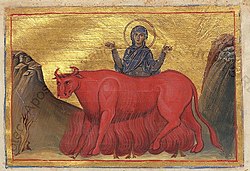| Saint Pelagia of Tarsus | |
|---|---|
 Miniature from the Menologion of Basil II Miniature from the Menologion of Basil II | |
| Died | 301–305 |
| Venerated in | Eastern Orthodox Church Roman Catholic Church |
| Feast | 4 May (Eastern Orthodox and Roman Catholic) 8 October(Eastern Orthodox) |
Pelagia (Ancient Greek: Πελαγία; d. early 4th century), distinguished as Pelagia of Tarsus and Pelagia the Martyr (Πελαγία ἡ Μάρτυς, Pelagía ē Mártys), was a legendary Christian saint and martyr who lived in Tarsus in Cilicia (southeastern Asia Minor) during the reign of Roman emperor Diocletian. Originally, her feast day was celebrated on October 8, in common with Saints Pelagia the Virgin & Pelagia the Harlot, both of Antioch.
Legend
According to tradition, Diocletian's son, the heir to the throne, fell in love with her and wanted to marry Pelagia. She replied that she could not, because she had sworn to preserve her virginity and was wedded to Christ. In his sorrow, Diocletian's son committed suicide. Pelagia was sent to Rome by her pagan mother, where Diocletian asked her to become his wife. She refused, calling the emperor insane. She was then burnt to death, and her flesh melted and smells of myrrh pervaded throughout Rome. By some versions, she was burned within a brazen bull. The story concludes by relating that the pagans sent four lions to surround her bones, but instead they protected her bones from vultures and crows until a Christian bishop could recover them.
History
There is little historical base to the story, as Diocletian had a daughter Valeria but no sons—a fact of considerable importance to the history of his reign. However, he did carry out the last intensive persecution of Christians in Roman history, many of whose victims were indeed burned alive. Thus, Pelagia might have been an actual martyr of that time, even if under different circumstances than those recounted in the later story. More probably, commemorations of the historical martyr Pelagia at Tarsus were probably embellished and given a local setting at some point.
Constantine the Great built a church on the reputed site of her remains.
See also
References
Citations
- (in Greek) Ἡ Ἁγία Πελαγία ἡ Μάρτυς. 4 Μαΐου. ΜΕΓΑΣ ΣΥΝΑΞΑΡΙΣΤΗΣ.
- ^ Kirsch (1911).
- Lives of all saints commemorated on May 4. Retrieved 2010-06-12.
- Herbermann (1913), p. 602.
Bibliography
- Herbermann, Charles G. (1913), The Catholic Encyclopedia: An International Work of Reference on the Constitution, Doctrine, Discipline, and History of the Catholic Church, vol. 11, New York: The Encyclopedia Press, Inc
- Kirsch, Johann Peter (1911), "Pelagia" , Catholic Encyclopedia: An International Work of Reference on the Constitution, Doctrine, Discipline, and History of the Catholic Church, Vol. 11, New York: Robert Appleton Co.
This article about a saint is a stub. You can help Misplaced Pages by expanding it. |